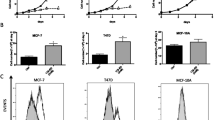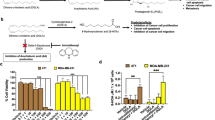Abstract
The role of TVA in suppressing proliferation of various human cancer cell lines was investigated that TVA and c9, t11-CLA both suppressed cell proliferation. The suppressive effect of TVA was clearly observed in T47D breast carcinoma cells after stearoyl-CoA desaturase-1 (SCD) knockdown using small interfering RNA (siRNA), demonstrating TVA directly affects suppression of human breast carcinogenesis.
Similar content being viewed by others
References
Craig-Schmidt MC. World-wide consumption of trans fatty acids. Atheroscler. 7(Suppl.): 1–4 (2006)
Awad AB, Herrmann T, Fink CS, Horvath PJ. 18:1 n7 fatty acids inhibit growth and decrease inositol phosphate release in HT-29 cells compared to n9 fatty acids. Cancer Lett. 91: 55–61 (1995)
Aro A, Männistö S, Salminen I, Ovaskainen ML, Kataja V, Uusitupa M. Inverse association between dietary and serum conjugated linoleic acid and risk of breast cancer in postmenopausal women. Nutr. Cancer 38: 151–157 (2000)
Rissanen H, Knekt P, Järvinen R, Salminen I, Hakulinen T. Serum fatty acids and breast cancer incidence. Nutr. Cancer 45: 168–175 (2003)
Shannon J, King IB, Moshofsky R, Lampe JW, Gao DL, Ray RM, Thomas DB. Erythrocyte fatty acids and breast cancer risk: a casecontrol study in Shanghai, China. Am. J. Clin. Nutr. 85: 1090–1097 (2007)
King IB, Kristal AR, Schaffer S, Thornquist M, Goodman GE. Serum trans-fatty acids are associated with risk of prostate cancer in beta-carotene and retinol efficacy trial. Cancer Epidemiol. Biomarkers Prev. 14: 988–992 (2005)
Miller A, McGrath E, Stanton C, Devery R. Vaccenic acid (t11-18:1) is converted to c9, t11-CLA in MCF-7 and SW480 cancer cells. Lipids 38: 623–632 (2003)
Banni S, Angioni E, Murru E, Carta G, Melis MP, Bauman D, Dong Y, Ip C. Vaccenic acid feeding increases tissue levels of conjugated linoleic acid and suppresses development of premalignant lesions in rat mammary gland. Nutr. Cancer 41: 91–97 (2001)
Corl BA, Barbano DM, Bauman DE, Ip C. Cis-9, trans-11 CLA derived endogenously from trans-11 18:1 reduces cancer risk in rats. J. Nutr. 133: 2893–2900 (2003)
Ip C, Banni S, Angioni E, Carta G, McGinley J, Thompson HJ, Barbano D, Bauman D. Conjugated linoleic acid-enriched butter fat alters mammary gland morphogenesis and reduces cancer risk in rats. J. Nutr. 129: 2135–2142 (1999)
Sauer LA, Dauchy RT, Blask DE, Krause JA, Davidson LK, Dauchy EM, Welham KJ, Coupland K. Conjugated linoleic acid isomers and trans fatty acids inhibit fatty acid transport in hepatoma 7288CTC and inguinal fat pads in Buffalo rats. J. Nutr. 134: 1989–1997 (2004)
Lock AL, Corl BA, Barbano DM, Bauman DE, Ip C. The anticarcinogenic effect of trans-11 18:1 is dependent on its conversion to cis-9, trans-11 CLA by delta9-desaturase in rats. J. Nutr. 134: 2698–2704 (2004)
Blewett HJ, Gerdung CA, Ruth MR, Proctor SD, Field CJ. Vaccenic acid favourably alters immune function in obese JCR:LA-cp rats. Brit. J. Nutr. 102: 526–536 (2009)
Brinkley BR, Beall PT, Wible LJ, Mace ML, Turner DS, Cailleau RM. Variations in cell form and cytoskeleton in human breast carcinoma cells in vitro. Cancer Res. 40: 3118–3129 (1980)
Siciliano MJ, Barker PE, Cailleau R. Mutually exclusive genetic signatures of human breast tumor cell lines with a common chromosomal marker. Cancer Res. 39: 919–922 (1979)
Park BK, Moon HR, Yu JR, Kook J, Chai JY, Lee SH. Comparative susceptibility of different cell lines for culture of Toxoplasma gondii in vitro. Korean J. Parasitol. 31: 215–222 (1993)
Chen TR, Drabkowski D, Hay RJ, Macy M, Peterson Jr W. WiDr is a derivative of another colon adenocarcinoma cell line, HT-29. Cancer Genet. Cytogenet. 27: 125–134 (1987)
Leibovitz A, Stinson JC, McCombs 3rd WB, McCoy CE, Mazur KC, Mabry ND. Classification of human colorectal adenocarcinoma cell lines. Cancer Res. 36: 4562–4569 (1976)
Chen TR. Re-evaluation of HeLa, HeLa S3, and HEp-2 karyotypes. Cytogenet. Cell Genet. 48: 19–24 (1988)
Livak KJ, Schmittgen TD. Analysis of relative gene expression data using real-time quantitative PCR and the 2[-Delta Delta C(T)] Method. Methods 25: 402–408 (2001)
Laemmli UK. Cleavage of structural proteins during the assembly of the head of bacteiophage T4. Nature 227: 680–685 (1970)
Pollard MR, Gunstone FD, James AT, Morris LJ. Desaturation of positional and geometric isomers of monoenoic fatty acids by microsomal preparations from rat liver. Lipids 15: 306–314 (1980)
De la Torre A, Debiton E, Durand D, Chardigny JM, Berdeaux O, Loreau O, Barthomeuf C, Bauchart D, Gruffat D. Conjugated linoleic acid isomers and their conjugated derivatives inhibit growth of human cancer cell lines. Anticancer Res. 25: 3943–3949 (2004)
Donnelly C, Olsen AM, Lewis LD, Eisenberg BL, Eastman A, Kinlaw WB. Conjugated linoleic acid (CLA) inhibits expression of the Spot 14 (THRSP) and fatty acid synthase genes and impairs the growth of human breast cancer and liposarcoma cells. Nutr. Cancer 61: 114–22 (2009)
Tanmahasamut P, Liu J, Hendry LB, Sidell N. Conjugated linoleic acid blocks estrogen signaling in human breast cancer cells. J. Nutr. 134: 674–680 (2004)
Ochoa JJ, Farquharson AJ, Grant I, Moffat LE, Heys SD, Wahle KW. Conjugated linoleic acids (CLAs) decrease prostate cancer cells proliferation: Different molecular mechanisms for cis-9, trans-11, and trans-10, cis-12 isomers. Carcinogenesis 25: 1185–1191 (2004).
Palombo JD, Ganguly A, Bistrian BR, Menard MP. The antiproliferative effects of biologically active isomers of conjugated linoleic acid on human colorectal and prostatic cancer cells. Cancer Lett. 28: 163–172 (2002)
Shultz TD, Chew BP, Seaman WR, Luedecke LO. Inhibitory effect of conjugated dienoic derivatives of linoleic acid and beta-carotene on the in vitro growth of human cancer cells. Cancer Lett. 63: 125–133 (1992)
Author information
Authors and Affiliations
Corresponding author
Rights and permissions
About this article
Cite this article
Oh, JJ., Lee, JS., Lim, JN. et al. Trans vaccenic acid (trans-11 18:1), a precursor of cis-9, trans-11-conjugated linoleic acid, exerts a direct anti-carcinogenic function in T47D breast carcinoma cells. Food Sci Biotechnol 23, 641–646 (2014). https://doi.org/10.1007/s10068-014-0087-3
Received:
Revised:
Accepted:
Published:
Issue Date:
DOI: https://doi.org/10.1007/s10068-014-0087-3




